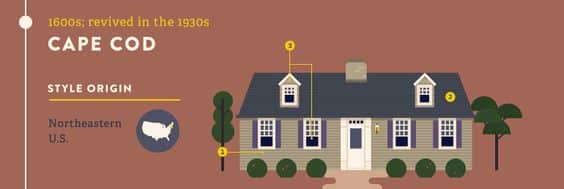“More than 50% of Seattle home buyers say identifying their favorite home style makes them feel more confident in the search.” — Trulia
Have you ever driven by a house in Seattle, Snohomish County, or even tucked in the trees of King County and thought, “That’s the one,” but couldn’t quite describe the popular home design styles to your broker.
You’re not alone.
Many home sellers and buyers love a certain look but get stuck trying to name that style. And let’s be honest—words like “Craftsman,” “Mid-century,” or “Tudor” can feel like another language if you don’t use them every day.
That’s why we created this guide—so you can walk into your next home conversation feeling like the expert. And hey, if you’re selling a home in Seattle, knowing your style can help you market it more effectively to the right buyers.
This updated article from The Madrona Group includes a simple list of 20 popular home design styles that are common around Seattle and across the country. You’ll find straightforward descriptions, hallmark features, and a few fun facts to help you get a feel for each look.
What To Expect In This Blog Post
- A quick list of the Top 10 most popular home styles in the U.S.
- A full breakdown of 20 home design styles with their key features
- Seattle-area examples of where you’ll see each style
- Links to additional tips for sellers, buyers, and home prep
Top 10 Most Popular Home Design Styles in the U.S.
According to Trulia, these home styles rank as the most searched and beloved across the country—and they’re all well represented right here in the Pacific Northwest.
- Ranch (Rambler) – One-story layout, often with an open floor plan.
- Craftsman – Exposed rafters, tapered porch columns, wood or stone siding.
- Contemporary – Clean lines, big windows, eco-conscious materials.
- Colonial – Symmetrical design, brick or wood exteriors, classic appeal.
- Cape Cod – Steep rooflines, dormer windows, coastal New England charm.
- Victorian – Ornate, colorful, with turrets and decorative trim.
- Tudor – Decorative timbering, steep gables, multi-pane windows.
- Mid-Century Modern – Flat or gabled roofs, floor-to-ceiling glass.
- Mediterranean – Stucco walls, red tile roofs, arched windows.
- Cottage – Quaint, cozy, with casement windows and flower boxes.
If you’re prepping your home for sale, make sure your style shines through your marketing.
List of 20 Popular Home Design Styles and a Description of What Makes Them Unique
TUDOR HOME STYLE

1485-1603
Origin: England
Features:
Siding
Brick laid in an elaborate pattern on the first story; stucco or wood with decorative trim on the second story.
Roof
Steep Roof. Prominent cross gables.
Windows
Casement windows. Windows grouped in rows of 3 or more.
Other Elements
Decorative half timbering
CAPE COD HOME STYLE
1600’s and revived in the 1930’s
Origin: Northeastern US
Features:
Siding
Traditional wood shingles. Modern: stone, stucco, brick.
Roof
Steep Roof. Shallow Overhang.
Windows
2 windows on each side of the entry door. Multi pane windows. Dormer on each side of the chimney.
GEORGIAN HOME STYLE
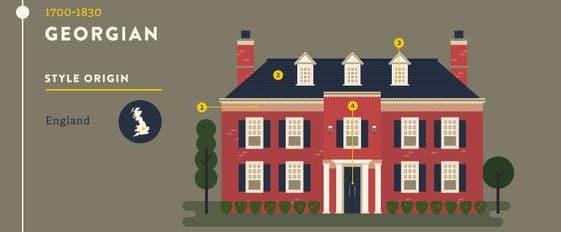
1700-1830
Origin: England
Features:
Siding
Wood with clapboard or shingle cladding. Occasionally decorated with wooden quoins. Stone, stucco, or brick.
Roof
Hip roof.
Windows
Dormers. Double hung sash windows. Small panes.
Other Elements
Symmetrical. Entrances are often fitted with pediments, arched tops, or ogee caps.
GREEK REVIVAL HOME STYLE
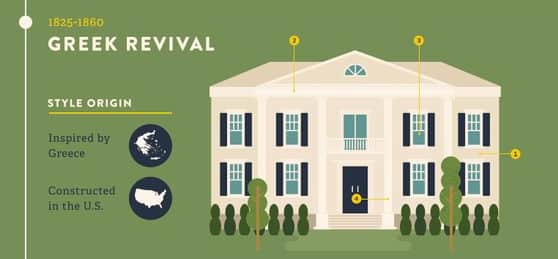
1825-1860
Origin: Inspired by Greece, Constructed in US
Features:
Siding
Often painted white to resemble marble temples in Greece. Stucco, wood.
Roof
Low pitched or hip roof. Gables with pediments. Cornice with wide bands of trim.
Windows
Tall double hung windows.
Other Elements
Simple moldings. Fluted or smooth columns. Pilasters.
COLONIAL HOME STYLE
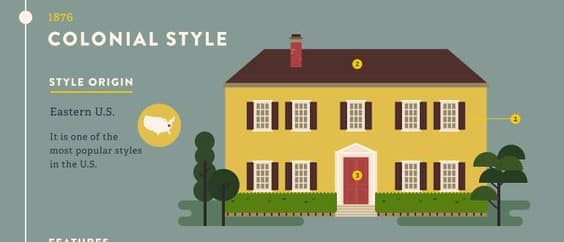
1876
Origin: Eastern US
Features:
Siding
Brick or wood.
Roof
Medium pitched roof.
Windows
2 Windows on each side of the entry door. 5 windows on the second floor. One window above the entry door.
(VICTORIAN) GOTHIC REVIVAL HOME STYLE
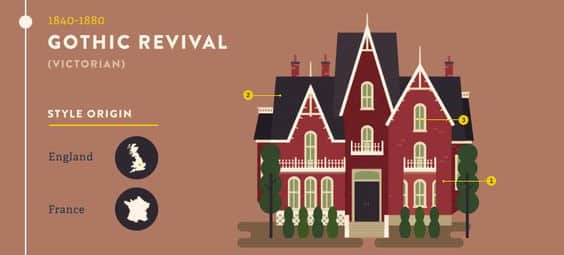
1840-1880
Origin: England & France
Features:
Siding
Middle class homes: wood. Wealthy homes: stone or brick.
Roof
Steep, complex. Elaborate verge board trim along roof edge.
Windows
High dormers. Arched or lancet windows.
(VICTORIAN) ITALIANTE HOME STYLE

1850-1890
Origin: England
Features:
Siding
Middle class homes: Wood. Wealthy homes: Stone or Brick.
Roof
Flat or hip roof. Corniced eaves.
Windows
Fanciful bay windows with inset wooden panels. Two over two double hung windows. Curved or molded window caps.
Other Elements
Corinthian columned porches. Square tower or cupola.
(VICTORIAN) STICK-EASTLAKE HOME STYLE

1860-1890
Origin: Fort Dearborn, Illinois
Features:
Siding
Wood. Small horizontal, vertical, or diagonal planks placed on top of the exterior walls.
Roof
Steep, gabled roof. Trusses or decorative shingles on gable ends. Complex, intersecting roof planes.
Windows
Jerkinhead dormers. Decorative windows.
Other Elements
Wrap around porch. Bold paneled brick chimneys. Overhanging, 2nd story porches. Elaborately decorated and very fanciful.
(VICTORIAN) SECOND EMPIRE HOME STYLE

1865-1880
Origin: France
Features:
Siding
Wooden Clapboard.
Roof
Mansard roof. Narrow eaves with brackets below. Round cornices at the top and base of the roof.
Windows
Tall narrow windows. Dormer windows that project from the roof (eyebrow dormers). Bay windows.
Other Elements
Tower. Wrought iron galleries or “crests” above the upper cornice. Balconies. Small entry porch.
(VICTORIAN) QUEEN ANNE HOME STYLE
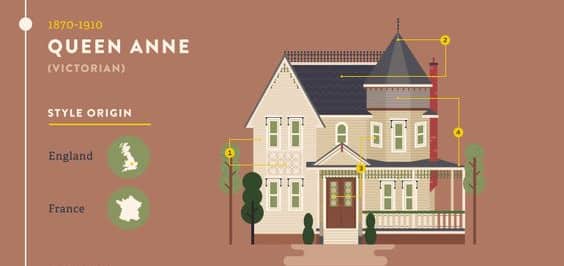
1870-1910
Origin: England & France
Features:
Siding
Stone, brick, or wood. Decorative trim. Carvings and/or inset panels of stone or terra cotta.
Roof
Roof finials. Patterned shingles.
Windows
Angled bay windows.
Other Elements
Cantilevered upper stories. Elaborate exterior decoration. Turrets, towers or cupolas. Wrap around porch. Balconies. Cresting. Detached gazebos.
(VICTORIAN) SHINGLE HOME STYLE
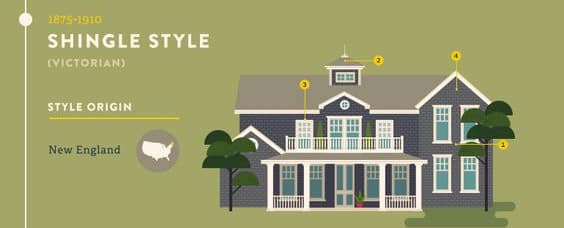
1875-1910
Origin: New England
Features:
Siding
Natural or single color shingles. Lacks elaborate ornamentation.
Roof
Complex roof forms. Asymmetrical gables.
Windows
Large windows.
Other Elements
High vaulted ceiling. Represents the transition from Victorian opulence to the simpler arts and crafts period.
DUTCH COLONIAL HOME STYLE

1890-1930
Origin: New York & New Jersey
Features:
Siding
Bric-a-brac, fish scale, clapboard, or shingles.
Roof
Gambrel roof. Flared eaves. Cross gabled roof.
Windows
8 over 8 windows. Shed, hip or gabled dormers.
Other Elements
Gable end chimney. Columned porch and entry. Porch under overhang eaves.
NEO-CLASSICAL HOME STYLE
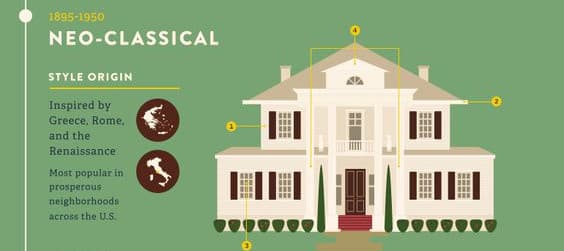
1890-1950
Origin: Inspired by Greece & Rome, Built in Prosperous Neighborhoods in US
Features:
Siding
Brick, stucco, wood, or vinyl.
Roof
Simple side gabled roof. Triangle pediment above entrance. Dentil molding or balustrades along roof line.
Windows
Elaborate pediments. Balanced array.
Other Elements
Symmetrical. Prominent portico. Full width porch with columns.
CRAFTSMAN STYLE
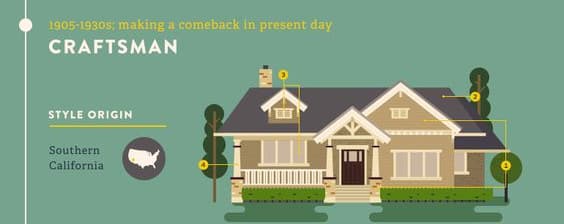
1905-1930’s & Making a Comeback Today
Origin: Southern California
Features:
Siding
Wood or stone.
Roof
Low pitched roof. Wide overhanging eaves. Decorative beams or braces under gables.
Windows
Dormer windows. Multi-paned top sashes and single-paned bottom sashes. Stained glass.
Other Elements
Large amount of interior woodwork. Exposed roof rafters. Full or partial porches framed by tapered square columns.
COTTAGE STYLE

1920’s-1930’s
Origin: England
Features:
Siding
Brick, stone, stucco and natural materials.
Roof
Steep overhanging roof. Cross gables.
Windows
Casement windows. Window boxes. Small panes. Shutters.
FRENCH COLONIAL STYLE
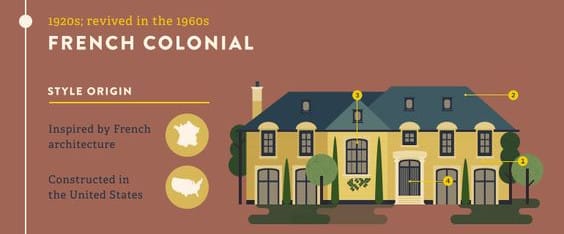
1920’s Revived in the 1960’s
Origin: Inspired by French Architecture, Built by US
Features:
Siding
Brick.
Roof
Steep and high. Hip roof.
Windows
Tall second story windows. Double french windows with shutters.
Other Elements
Balanced and symmetrical proportions. Porches with substantial balustrades. Arched doorways.
MEDITERRANEAN STYLE
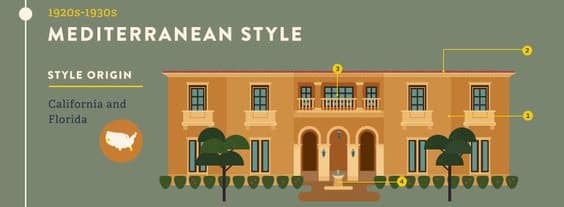
1920’s – 1930’s
Origin: California & Florida
Features:
Siding
Stucco, adobe.
Roof
Low pitched roof. Tile roof (often red).
Windows
Large windows.
Other Elements
U-shaped floor plan oriented around a central courtyard or fountain, which promotes cooling and cross-ventilating. Grillwork.
MID-CENTURY MODERN STYLE
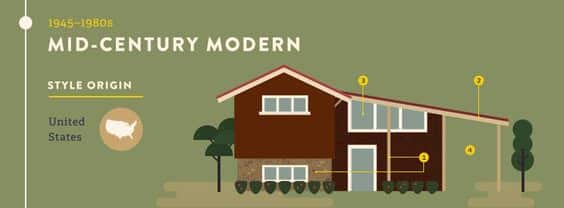
1945 – 1980’s
Origin: US
Features:
Siding
Stone, glass, brick.
Roof
Flat. Gabled.
Windows
Oversized windows. Transom windows. Sliding glass doors.
Other Elements
Open space. Double wide entry doors.
TRADITIONAL RANCH STYLE
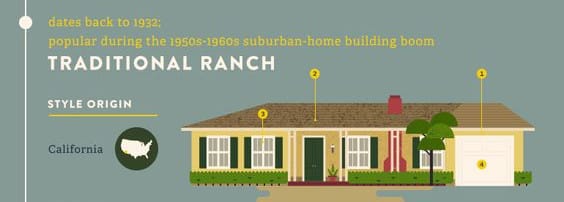
1932 – Popular in the 1950’s – 1960’s
Origin: California
Features:
Siding
Brick, wood, stucco.
Roof
Hipped or gabled roof. Wide overhanging eaves.
Windows
Picture windows. Sliding glass doors.
Other Elements
Box, cubic, or L- or U-shaped layout. Simple floor plan. Attached garage. Minimal ornamentation.
CONTEMPORARY STYLE
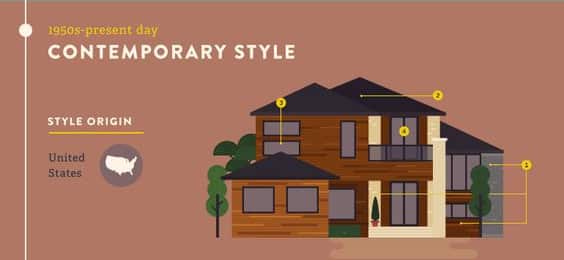
1950’s – Present
Origin: US
Features:
Siding
Simple ornamentation. Focus on natural elements: stone, brick, wood.
Roof
Steep and high. Hip roof.
Windows
Large windows, sometimes floor to ceiling. Irregularly-shaped.
Other Elements
Open floor plan. Natural light. Bold geometric shapes. Local or recycled building material. Eco-friendly materials and features.
MOST POPULAR AND ICONIC HOME DESIGN STYLES INFOGRAPHIC
CLICK IMAGE FOR FULL SIZE VERSION
Courtesy of: PartSelect.com
Frequently Asked Questions About Home Design Styles
What’s the most popular home style in the Seattle area?
In Seattle and the greater Puget Sound, Craftsman, Mid-century modern, and Contemporary homes lead the pack. In suburban areas like Lynnwood and Edmonds, you’ll also see plenty of Ranch and Cape Cod styles.
How do I find homes by style when searching online?
Use real estate sites with filters or apps like the John L. Scott mobile search tool. If you’re working with a broker, just send a photo or style name and they can narrow down listings for you.
Does home style affect resale value?
Yes. A home that fits its neighborhood, has clear architectural character, and is marketed with its style in mind often sees stronger interest—and sometimes higher offers. Style matters.
Quick Takeaways
- Ranch homes are the most popular across the country.
- Seattle buyers love Craftsman, Mid-century, and Contemporary homes.
- Style adds personality, value, and appeal to your listing.
- If you’re not sure what style your home is, your broker can help you identify and market it.
Want to increase your home’s value before you list? Consider these easy resale-boosting home updates.
Final Thoughts on Popular Home Design Styles
If you’re planning to sell a home in Seattle, understanding your home’s architectural style can be a big advantage. It helps you attract buyers who are already looking for exactly what you have—and gives your marketing a clear, appealing narrative.
And if you’re shopping for a new place, learning to spot different styles helps you zero in on homes that match your taste and lifestyle.
Whether your home is a storybook Tudor, a sleek Mid-century, or a timeless Colonial, its style is one of its greatest assets. When you’re ready to put that story in front of buyers, The Madrona Group is ready to help you make it shine.
Share this post!



